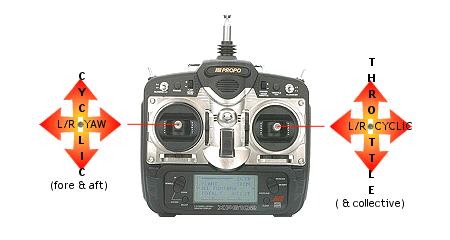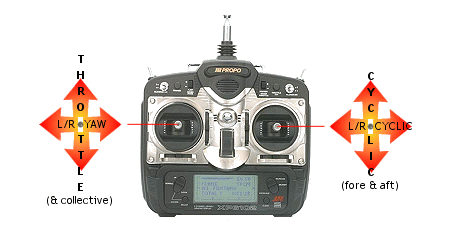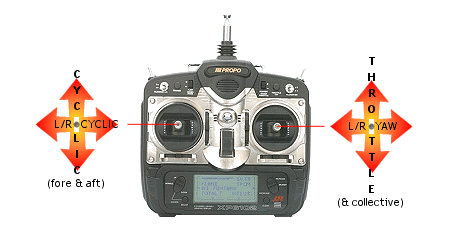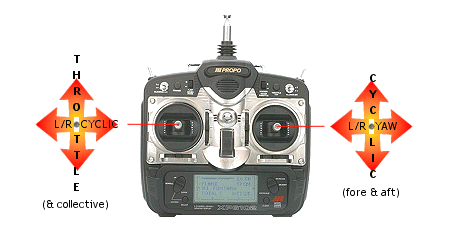RC helicopter transmitter modes
The set-ups for rc helicopter transmitter modes roughly echo the ones for rc plane transmitters in terms of pitch, roll, yaw and throttle. And as with rc airplanes, Mode 2 is by far the most common mode in use today.
There was a time, back in the 1980s/90s, when rc transmitters were different for each aircraft type - one transmitter for planes, one for helicopters. This was because the aircraft functions differed and the technology wasn't there to share a single transmitter for both aircraft types.
Nowadays, of course, that has changed and modern rc transmitters can cope with all manner of programming requirements, so one transmitter can be used for multiple aircraft types. Not just planes and helis, but drones and sailplanes too.
The four different rc helicopter transmitter modes are illustrated below:
Mode 1

Stick controls are:
left stick operates fore/aft cyclic & left/right yaw, right stick operates throttle/collective & left/right cyclic.
Mode 2

Stick controls are:
left stick operates throttle/collective & left/right yaw, right stick operates fore/aft cyclic & left/right cyclic.
Mode 3

Stick controls are:
left stick operates fore/aft cyclic & left/right cyclic, right stick operates throttle/collective & left/right yaw.
Mode 4

Stick controls are:
left stick operates throttle/collective & left/right cyclic, right stick operates fore/aft cyclic & left/right yaw.
As you can see, mode 3 is the opposite to mode 2 and mode 4 is the opposite to mode 1, giving complete right handed/left handed user options.
Pros and Cons of each Mode
No mode is better than another one, and the choice of which transmitter mode you use comes down to either personal preference or which mode you learned to fly with (i.e. you inherit your instructor's Tx mode).
There are minor pros and cons to each mode. For example, take Mode 1; the two primary pitch controls are on separate sticks. This is good because if you move each control independently then there is no chance of you inadvertently changing one while moving the other. But Mode 2 has both these primary controls on the same stick, which replicates the cyclic stick of a real helicopter, making the control of your model more true to life and only one thumb having to worry about these main controls.
Most modern transmitters, certainly ones from the top manufacturers, are only produced in a Mode 2 configuration these days, and this is a reflection on the global market.
If you want to change mode, a few simple changes in the programming menu need to be made, and you'll need to open the Tx casing and swap a small spring (and possibly a ratchet) from one stick to the other. Detailed instructions are provided by the manufacturers, in the manual.
Once you've learned to fly rc helicopters on a certain transmitter mode, the chances are that you'll stick with that same mode throughout your flying days. Re-learning to fly on a different mode is essentially the same as starting from scratch!
